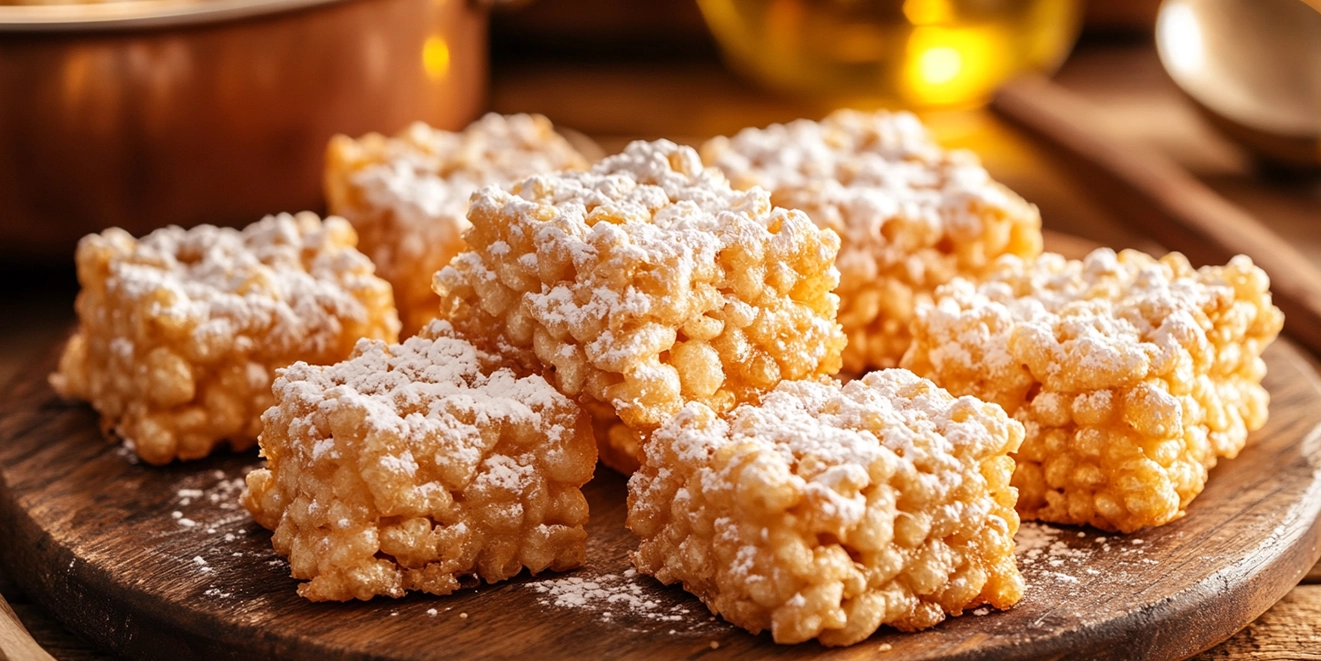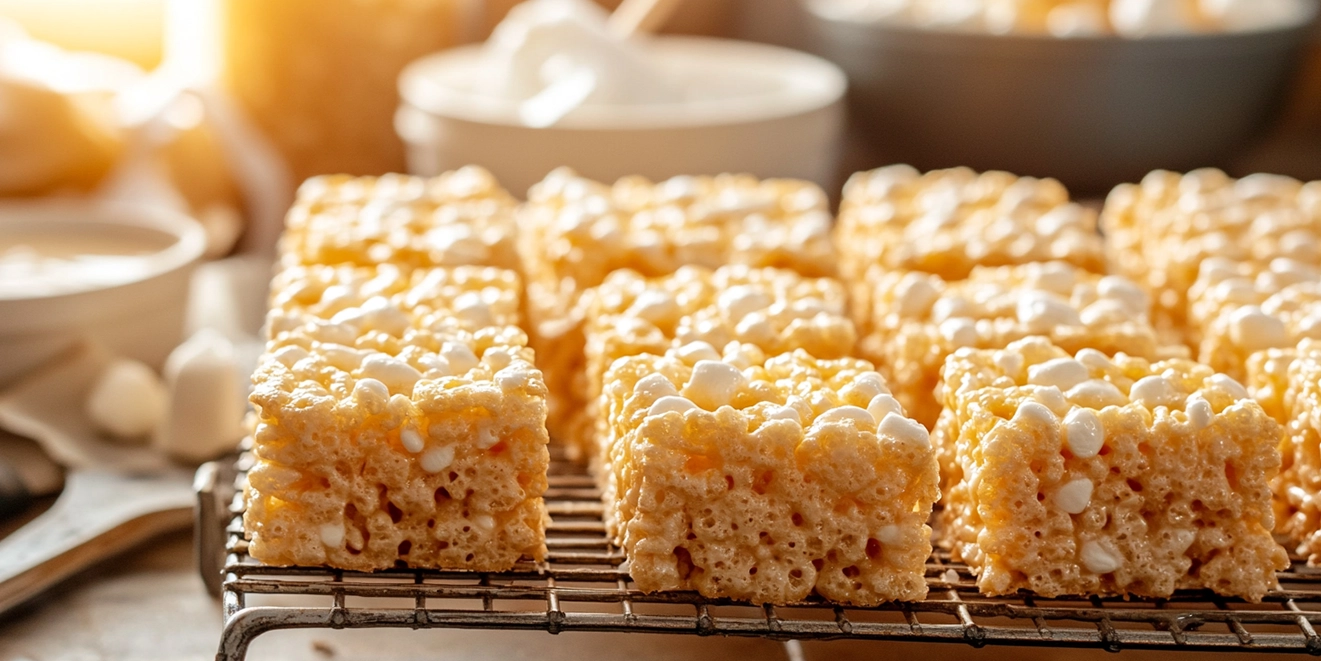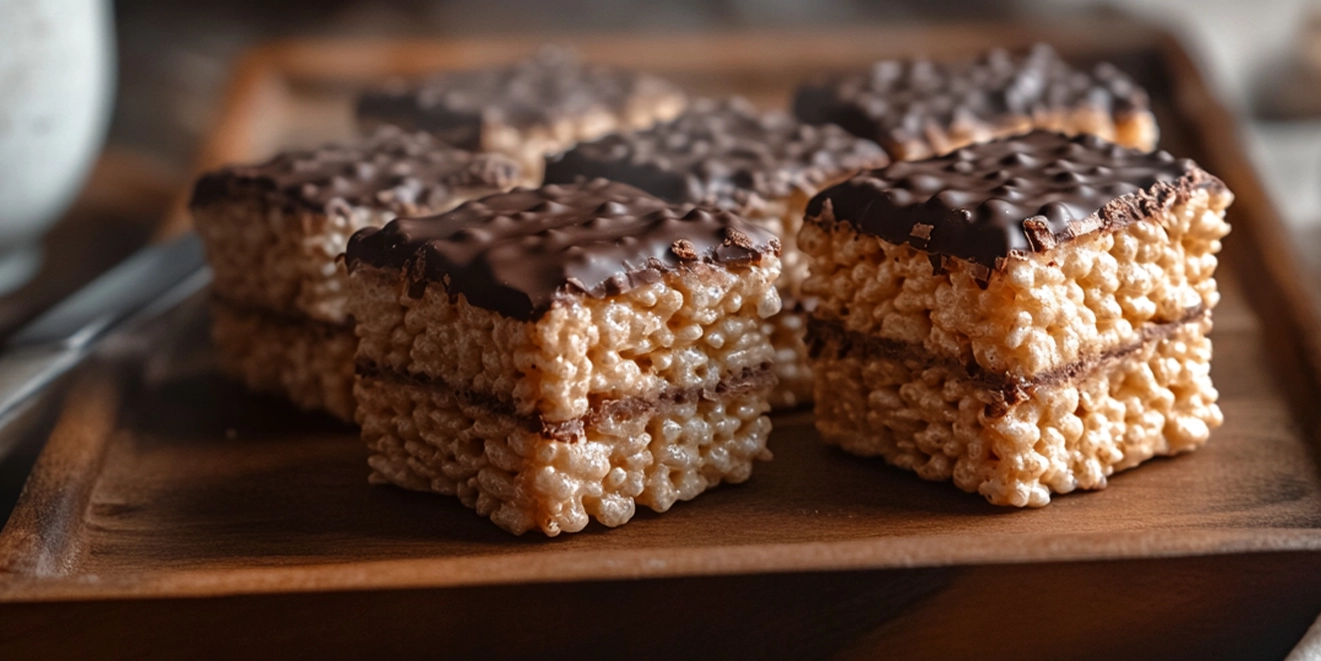Rice Krispies: Production, Health Facts, and Popular Uses Explained

Introduction to Rice Krispies
What are Rice Krispie?
Rice Krispie is a popular breakfast cereal made from puffed rice. Known for their light, crispy texture, and distinct “snap, crackle, and pop” sound when milk is added, they are enjoyed worldwide. In addition to being a breakfast staple, Rice Krispie are a key ingredient in various snacks and desserts, most notably Rice Krispie Treats.
Origin and History of Rice Krispies
Rice Krispie were introduced in 1928 by the Kellogg Company, a leading name in the cereal industry. The idea was to create a light, crunchy cereal from whole-grain rice. Their unique sound and texture made them an instant success.
The cereal gained further popularity in 1939 when the first recipe for Rice Krispie Treats was published. This simple dessert, made by combining Rice Krispie, melted marshmallows, and butter, became a classic American favorite, particularly during holidays and family gatherings.
The cereal’s mascots, Snap, Crackle, and Pop, debuted in 1933. These playful, animated figures became iconic in Kellogg’s advertising, reinforcing Rice Krispie’ fun and distinctive characteristics.
Ingredients of Rice Krispies
The primary ingredients of Rice Krispies are:
- Rice – Whole-grain rice is the core ingredient, puffed to create a light, crispy texture.
- Sugar – Adds a slight sweetness to balance the flavor.
- Salt – A small amount is used to enhance the cereal’s taste.
- Barley Malt Flavoring – Provides a subtle, malty flavor to the cereal.
- Vitamins and Minerals—Fortified with essential nutrients such as iron, niacinamide (Vitamin B3), and folic acid, it is a nutritious breakfast choice.
In some regions, manufacturers produce Rice Krispies without barley malt, making them gluten-free. However, always check the packaging to confirm.
The Production Process of Rice Krispies
Step-by-Step Manufacturing Process
The production of Rice Krispies involves transforming whole-grain rice into the light, crispy puffs we recognize. Here is a step-by-step breakdown of the process:
- Preparation of Rice
- Manufacturers clean and sort whole-grain rice to remove any impurities. The rice grains are then pre-cooked and partially dried to prepare them for the next stages.
- Cooking and Puffing
- The pre-cooked rice undergoes high-pressure cooking in steam ovens, which gelatinizes the starch in the rice. After cooking, the rice is quickly dried and heated at very high temperatures, causing the grains to puff. This rapid puffing process creates the light, airy texture of Rice Krispies.
- Cooling
- The puffed rice is cooled to maintain its crispy structure and prevent the grains from sticking together.
- Flavoring and Fortification
- The cooled Rice Krispies are lightly coated with sugar, salt, and barley malt flavoring to enhance their taste.
- Vitamins and minerals are added to fortify the cereal, making it a nutritious breakfast choice.
- Quality Control
- Each batch of Rice Krispies undergoes strict quality control to ensure consistency in size, puffiness, and flavor.
- Packaging
- Finally, the Rice Krispies are carefully packaged in airtight bags and boxes to maintain their freshness and crispiness during transportation and storage.
How Rice Krispies Are Cooked: Key Stages
- Gelatinization of Rice
- Cooking the rice under pressure allows the starch molecules to gelatinize, making the grains pliable and ready for puffing.
- Puffing Process
- Puffing occurs when rice is exposed to intense heat. The rapid moisture evaporation inside the grains causes them to expand and puff instantly.
- Drying and Cooling
- The puffed grains are dried and cooled quickly to lock in their structure and ensure crispness.
Are Rice Krispies Fried?

Understanding the Term “Fried”
“fried“ generally refers to cooking where food is submerged in hot oil or fat to create a crispy texture. There are two main types of frying:
- Deep Frying: Food is wholly immersed in hot oil.
- Shallow Frying: Food is cooked with minimal oil in a pan.
In contrast, puffing methods like those used to produce Rice Krispies rely on dry heating rather than oil-based frying. This distinction is crucial for understanding the production process of Rice Krispies.
Why People Think Rice Krispies Are Fried
Many people assume Rice Krispies are fried because of their:
- Crispy Texture: The light, airy crunch of Rice Krispies resembles the crispiness of fried food.
- Golden Appearance: The puffed rice grains have a slight golden hue, similar to fried foods.
- Cooking Heat: High heat is essential for puffing rice, which can give the impression of frying.
However, Rice Krispies are not fried. Instead, they are cooked using a dry heat process that causes the rice to puff without oil.
Are Rice Krispies Baked?

Baking Methods in Food Manufacturing
Baking in food manufacturing involves cooking food using dry heat, typically in an oven or under conditions that simulate an oven. This method eliminates the need for oil and produces a crispy or dry texture. In industrial settings, baking is achieved using:
- Convection Ovens: Hot air circulates the food to ensure it is even cooking.
- High-Temperature Dry Heat: Foods are exposed to intense, controlled heat to remove moisture and create a specific texture.
- Continuous Baking Systems: Food moves through a heated tunnel on a conveyor, ensuring uniform results at scale.
Why Rice Krispies are Baked, Not Fried
Rice Krispies are not fried but undergo a unique process that resembles baking. The steps involve:
- High-Pressure Cooking: Whole-grain rice is steamed to gelatinize the starch, softening the grains.
- Puffing with Dry Heat: The cooked rice is subjected to high, dry heat in a specialized oven. The rapid exposure to heat causes the moisture inside the rice grains to evaporate quickly, resulting in puffing.
- Drying and Cooling: The grains are cooled and dried to lock in their airy, crispy texture after puffing.
This process mirrors baking more closely than frying because no oil is used, and the puffing relies entirely on heat and moisture evaporation.
Nutritional Implications of Baking
Baking, as opposed to frying, has significant nutritional benefits:
- Lower Fat Content: Since no oil is used during the puffing process, Rice Krispies are naturally low in fat and calories.
- Reduced Calories: Foods baked or puffed without oil tend to have fewer calories than fried alternatives.
- Preservation of Nutrients: The baking-like process helps retain the rice’s nutritional integrity while allowing fortification with essential vitamins and minerals (e.g., iron, Vitamin B3, and folic acid).
- Light and Digestible: Baking creates a light, airy product that is easy to digest, making Rice Krispies a popular choice for kids and adults.
The Science Behind Rice Krispies
How Puffed Rice is Made
The production of puffed rice, like the process used for Rice Krispies, is rooted in food science and physics. The key steps involve transforming rice grains into their puffed, crispy form:
- Gelatinization of Starch
- Whole-grain rice is cooked under high-pressure steam. This process gelatinizes the starch molecules in the rice, meaning the grains soften, and the starch structure changes to hold moisture.
- Rapid Puffing
- Once cooked, the rice is exposed to intense dry heat or is rapidly depressurized. The sudden exposure causes the water inside the rice grains to turn into steam instantly.
- The steam expands, forcing the grains to puff up and create the light, crispy texture we recognize in Rice Krispies.
- Drying and Cooling
- The puffed rice is quickly dried and cooled to maintain the structure, removing any residual moisture. This locks in the puffiness and crisp texture.
The result is a light, airy cereal that remains stable and crispy in packaging and when mixed with milk.
The Role of Heat and Pressure
Heat and pressure are the driving forces behind the puffing process. Here’s how they work together:
- Heat: When rice is exposed to extreme dry heat, the moisture inside evaporates rapidly, creating the necessary conditions for the expansion process.
- Pressure: High pressure during the initial cooking phase traps moisture inside the rice grains. Once the grains are released into a low-pressure environment or exposed to dry heat, the trapped moisture becomes steam, puffing the rice.
This process is similar to popcorn pops, where heat and pressure cause the kernel to expand rapidly.
Health Considerations of Rice Krispies
Nutritional Breakdown of Rice Krispies
Rice Krispies are a simple cereal made from puffed rice and are relatively low in fat and calories. Here is the general nutritional profile for a 1-cup (33g) serving of Rice Krispies:
- Calories: ~130
- Total Fat: 0g
- Carbohydrates: 29g
- Sugars: 4g
- Dietary Fiber: 0g
- Protein: 2g
- Sodium: 190mg
- Vitamins and Minerals: Fortified with iron, Vitamin B3 (niacin), folic acid, and Vitamin D.
Rice Krispies are low in fat and sugar but lack significant fiber and protein, making them a light, low-calorie option that works best as part of a balanced meal.
Are Rice Krispies a Healthy Snack?
Rice Krispies can be considered a healthy snack when eaten in moderation and as part of a balanced diet. Here’s why:
Pros:
- Low in Fat: No added oils or fats make them healthier than fried snacks.
- Low Calories: A serving is light and calorie-conscious, ideal for those watching their intake.
- Fortified with Nutrients: Added vitamins and minerals boost their nutritional value.
Cons:
- Low Fiber and Protein: Rice Krispies lack the fiber and protein to keep you full longer.
- Sugar Content: While relatively low, added sugar may concern those on a low-sugar diet.
Health Tip: Combine Rice Krispies with milk, fresh fruits, or nuts to increase their nutritional value and make them a more filling snack or breakfast option.
Popular Uses of Rice Krispies

Traditional Rice Krispies Treats
Rice Krispies Treats are a classic no-bake dessert enjoyed worldwide. They are made with three main ingredients:
- Rice Krispies Cereal
- Marshmallows
- Butter
How to Make: Melt marshmallows and butter, then mix in Rice Krispies. Press the mixture into a pan, allow it to set, and cut into squares.
This simple recipe is loved for its chewy, crispy texture and is often enhanced with chocolate drizzles, sprinkles, or peanut butter.
Rice Krispies in Baking and Desserts
Rice Krispies are versatile and can be used in various baked goods and desserts, including:
- Cookies: Add Rice Krispie to cookie dough for an extra crunch.
- Cakes: Use Rice Krispie as layers or decorations for a unique texture.
- Cereal Bars: Combine Rice Krispie with nuts, dried fruits, and honey for a healthier snack.
Creative Recipes Using Rice Krispies
Here are some creative ways to use Rice Krispies:
- Chocolate-Covered Rice Krispies Balls
- Roll Rice Krispie and marshmallow mixture into small balls. Dip them in melted chocolate for a bite-sized treat.
- Rice Krispie Crusted Chicken
- Crushed Rice Krispie can be used instead of breadcrumbs to coat baked chicken tenders. This creates a crispy, gluten-free crust.
- Rice Krispie Pancakes
- Add a handful of Rice Krispie to the pancake batter for a light, crunchy texture.
- Ice Cream Sandwiches
- Create thin Rice Krispie Treats and use them as “cookies“ for ice cream sandwiches.
Common Misconceptions About Rice Krispies
Rice Krispies Fried Myths vs. Facts
A common misconception is that Rice Krispie are fried because of their crispy texture and light golden appearance. Fact: Rice Krispie are not fried but puffed using high-pressure cooking and dry heat. This process is similar to baking and involves no oil, making them a lighter, healthier snack.
Clarifying the Production Process
The production of Rice Krispie involves:
- Steaming whole-grain rice under pressure (gelatinization).
- Puffing the rice by exposing it to high heat causes rapid moisture evaporation and expansion.
- Drying and cooling to lock in the crisp texture.
This method ensures Rice Krispie are oil-free, non-fried, and suitable for health-conscious consumers.
Are Rice Krispies Vegan or Gluten-Free?
Ingredients Analysis
- Vegan Status: While the main ingredients of Rice Krispie (rice, sugar, salt, and barley malt) appear vegan-friendly, some versions contain Vitamin D3, which comes from animal sources like lanolin found in sheep’s wool.
- Verdict: Traditional Rice Krispie are not strictly vegan.
- Gluten-Free Status: Rice is naturally gluten-free, but Rice Krispie contain barley malt flavoring, which has gluten.
- Verdict: Standard Rice Krispie are not gluten-free.
Suitable Alternatives for Dietary Needs
- Vegan Alternatives: Look for cereals labeled as vegan-friendly with plant-based Vitamin D2.
- Gluten-Free Alternatives: Gluten-free puffed rice cereals are widely available and can replace Rice Krispie.
Rice Krispies Around the World
Different Varieties of Rice Krispies
Kellogg’s has introduced various flavors and versions of Rice Krispie to suit global markets, including:
- Chocolate Rice Krispie: Cocoa-flavored puffed rice.
- Frosted Rice Krispie: Coated with a sweet sugar glaze.
- Rice Krispie Multigrain: Includes other grains like oats for added nutrition.
Global Preferences and Uses
- In the United States, Rice Krispie Treats are the most popular use of the cereal.
- In Asia, puffed rice cereals are commonly used in savory snacks.
- In the UK and Australia, variations like Rice Bubbles are widely consumed with milk for breakfast.
How to Make Homemade Rice Krispies
Baking Rice Krispies at Home
Creating puffed rice at home is a fun alternative to store-bought versions. Essential kitchen tools and methods can help you achieve this.
Step-by-Step Guide to Puffed Rice
Ingredients:
- 1 cup uncooked rice (white or brown)
Instructions:
- Pre-Cook the Rice: Boil the rice until fully cooked and soft. Drain any excess water.
- Dry the Rice: Spread the rice in a thin layer on a baking sheet and allow it to air-dry entirely or use a low oven setting (150°F or 65°C) for 1–2 hours.
- Puffing the Rice:
- Heat a dry, heavy skillet or deep pot over medium-high heat.
- Add small batches of dried rice and stir constantly. The rice will puff up as the moisture evaporates quickly.
- Cooling: Transfer the puffed rice to a baking sheet to cool.
Choosing Between Baking and Frying at Home
- Baking: Healthier with no added oil. Use an oven at low heat for puffing.
- Frying: Produces crunchier puffed rice but adds oil and calories.
For a healthier version, baking is recommended as it mirrors the commercial Rice Krispie production process.
FAQs About Rice Krispies
- Rice Krispie just fried rice?
No, Rice Krispie are not fried rice. While they are made from rice, the production process involves puffing the rice grains using high-pressure steam and dry heat, not oil. The moisture inside the rice evaporates rapidly under high heat, causing the grains to puff and become light and crispy. This method resembles baking more than frying and does not involve any oil.
- How do they make Rice Krispie?
The production process of Rice Krispie includes several key steps:
Cooking: Manufacturers steam whole-grain rice under high pressure to soften and gelatinize the starch.
Puffing: They expose the cooked rice to high, dry heat, which turns the trapped moisture into steam, causing the grains to puff and expand.
Drying and Cooling: Manufacturers quickly dry and cool the puffed rice to preserve its crispy texture.
Flavoring and Fortification: They add a light coating of sugar, salt, and barley malt flavoring, along with vitamins and minerals for fortification.
Packaging: They seal the final product to maintain its freshness and crispiness.
Can Muslims Eat Rice Krispie Treats?
Muslims should carefully check the ingredients, as some versions contain barley malt flavoring or gelatin, which might come from non-halal sources. Always verify with the manufacturer or look for halal-certified labels.
Rice Krispie Treats may not be suitable for Muslims depending on the ingredients:
- Marshmallows: Traditional marshmallows used in Rice Krispie Treats often contain gelatin derived from non-halal animal sources (e.g., pork), making them unsuitable for Muslims.
- Rice Krispie Cereal: The cereal may also contain Vitamin D3, which is often derived from lanolin (sheep’s wool). This can be a concern for strict dietary practices.
Solution: To make halal-friendly Rice Krispie Treats:
- Use halal-certified marshmallows made with plant-based or halal gelatin.
- Verify that your Rice Krispie cereal meets halal standards (some brands offer vegan or D2-fortified options).
Conclusion
Rice Krispie are a versatile, globally recognized cereal that has stood the test of time. Contrary to common misconceptions, they are not fried but puffed using a baking-like dry heat process, which ensures a light, crispy texture without added oils. This makes them a healthier alternative to fried snacks.
While Rice Krispie are low in fat and calories, they can vary in dietary suitability. For individuals following specific diets, such as halal, vegan, or gluten-free, checking the ingredients for additives like gelatin or barley malt is essential.
To enhance your Rice Krispie Treats content with related recipes and resources, consider linking to the following articles on QuickyCookRecipes.com:
- For more no-bake treats, check out the Dirt Cake Recipe, another easy and fun dessert perfect for any gathering.
- For a festive dessert twist, try the Apple Cobbler Recipe, a classic baked treat for fall or winter.
- If you’re looking for savory options, take advantage of the Chicken Quesadilla Recipe for a quick and satisfying meal.
- Curious about what makes Rice Krispie so unique? Learn more about what Rice Krispie Treats are made of.
Final Thoughts
Rice Krispie Treats are the perfect balance of simplicity and fun. They’re great for kids and adults alike and require minimal effort for maximum flavor. For more easy dessert ideas, explore the related recipes listed above and keep your kitchen full of delicious, quick treats!
